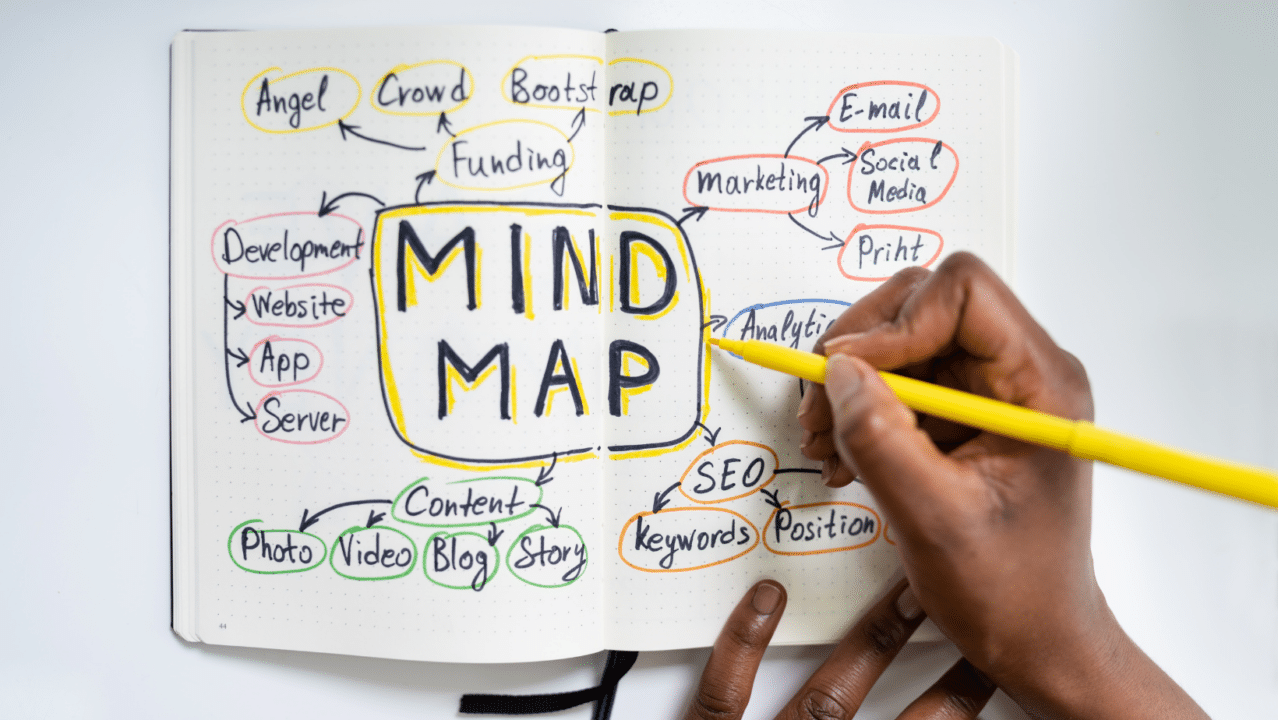Do you like writing? Well, we love it! Blogs, novels, fiction, academic publications – no matter what you’re writing, there is always a way to be more productive. That’s why we’ve compiled a list of the best digital writing tools and some creative writing techniques.
1. Visualize your thoughts – Mindmaps
Writing is, by all means, a creative process, however, keeping your ideas in line with each other and your story organized is definitely a “must”. A nice way to visualize your storyline and keep track of the macrostructure of your book is by creating a mindmap. Here’s how it looks like.

You can opt for an old-fashioned way and draw mind maps on paper, whiteboard or use a bunch of sticky notes. If you’re one of those geeky types, you can use Milanote, which is an app that allows you to create visual boards that include notes, images, and other files. Working in a team? Miro is another app, where you can share visual boards and work on the content together. Alternatively, you can always design mindmaps in PowerPoint.
2. Finding inspiration with digital writing tools
It’s 5 AM. You’re sitting at your desk for hours, staring at a blank paper sheet. Does this sound familiar to you? It surely does for most writers, we all know that feeling! Every piece of writing is different and thus requires a different approach.
However, if you’re searching for some ideas and inspiration, use Pinterest to your advantage. The best thing about Pinterest is that most content is visual. You don’t have to spend a lot of time, just skim through a dozen images to pick up some ideas on the go.
Other than that, you can use online tools, that generate random questions and topics, such as Portent and Conversation starter. Not all of the ideas suggested by these tools deserve a Nobel Prize, but at least you’ll have some fun in the process!
3. Making sure your text looks professional
Make sure to always double-check your grammar, spelling, punctuation, and language style. This makes a huge difference so make use of some of the best writing tools out there: Grammarly and Hemingway. Grammarly has an extension for Chrome and Word, which is a huge benefit! On the other hand, Hemingway is absolutely free and gives you solid writing advice. The only con is that you have to go to their website every time.
You probably know this one, but it’s still worth mentioning. Thesaurus is a great tool that you can use to search for synonyms, antonyms, and word suggestions. Besides, if you’re looking forward to expanding your vocabulary or learn new grammar rules – they have a blog, full of this kind of content!
Writing good headlines
If you are writing for marketing purposes, writing good headlines is vital. They are used to capture people’s attention, reflect the main point of the passage in 1 clear sentence or the opposite – create a mystery. Let’s review some examples just so you can have a clear picture of what we’re talking about.
| Good headline | Bad headline |
|---|---|
| 5 easy ways to learn Dutch | Learn Dutch easily |
| Learn the art behind killer headlines in 30 seconds or less | How to write killer headlines? |
| E-learning: a curse or a blessing? | How good is E-learning? |
From reviewing these examples you can already pick up some tips. First, it’s proven that including numbers helps to draw the reader’s attention. Not only that but also have a reference number already establishes expectations about the length of the article in the reader’s mind.
Furthermore, if your article touches upon 2 controversial viewpoints – it’s nice to already make it specific in the headline, so the reader can be prepared to hear arguments from 2 different perspectives.
Here’s Sharethrough, a nice website, that will help you to write great headlines. You can also use this tool to write compelling chapter names.
Beyond spell-checking
Also, if you’re writing for a large audience, you want to make sure that your text is easily readable and understandable for an average person. Online tools such as PrepostSeo rank your content based on common readability tests. The score ranges from 0 (completely unreadable) to 100 (easy-to-read even for children).
Take this figure seriously, only if you’re writing for the masses. If you’re writing something niche-based, keep your terminology and jargon the way they are.
4. Writing Faster
And now let’s talk about a huge game-changer for modern writers – speech recognition software. “Why not type the old-fashioned way?” – you may ask. Here’s why: professionals type at a rate of 65 words per minute, while the average person speaks at a pace of about 125 words a minute. You get the idea.
Recording audio and converting it to text saves a lot of valuable time! Also, do you know why so many writers have to wear glasses? You’ve guessed it because they type text and look at the computer screen the whole day! Doing a voice recording is less tiring, but also more demanding to external conditions (like noise).
You can opt for an old-fashioned way and draw mind maps on paper, whiteboard or use a bunch of sticky notes. If you’re one of those geeky types, you can use Milanote, which is an app that allows you to create visual boards that include notes, images, and other files. Working in a team? Miro is another app, where you can share visual boards and work on the content together. Alternatively, you can always design mindmaps in PowerPoint.

Currently, there are 2 ways you can transform your recordings to text – use the voice-typing feature in Google Docs (or other software packages) or upload your files to online transcription tools, like Amberscript. Voice-typing is quite convenient since it produces output immediately, but it also comes with a number of limitations.
First, Amberscript takes slightly longer to analyze your recording, but the reward is the higher accuracy of your transcription. Also, voice-typing tools usually don’t store your audio files, meaning that if something went wrong – you don’t have a backup.
Having an mp3 file separately is definitely nice since it allows you to go back and listen to your recordings manually if your recording conditions were poor.
Not only that, but you can take your collection of mp3 recordings and easily make an audio-book out of them!
Last, but not least, in our day and age we are surrounded by hundreds and thousands of distractions. If you find yourself distracted easily, check out this tool for writing (called “Calmly Writer”) – it offers basic functions and comes with a minimalistic layout to keep you concentrated!
Last… Staying Focused
Last, but not least, in our day and age we are surrounded by hundreds and thousands of distractions. If you find yourself distracted easily, check out this tool for writing (called “Calmly Writer”) – it offers basic functions and comes with a minimalistic layout to keep you concentrated!
Summary
Here’s a small infographic that summarizes the creative writing techniques that you’ve just read.

Here is a list of the best digital writing tools
Finding inspiration: Portent, Pinterest, Conversation Starter
Making sure your text looks professional: Grammarly, Hemingway, Sharethrough, Thesaurus, PrepostSeo
Writing Faster (transcription tool): Amberscript
We hope that now you’ll be writing with greater efficiency without putting in any extra effort! For more interesting reads like this, check out our blog!